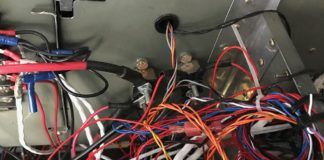
Editor’s note: In part 1 of this series (July 2012), we discussed preparation for building and decision-making tools. This time we continue with our conceptual approach to homebuilding tools by exploring the tools for managing a project and keeping you motivated throughout the build.
Building a homebuilt aircraft may be the most complex project you ever undertake. As the builder, you also get to be the banker, manufacturer, quality-control inspector and project manager. You might think there is no great need for project management, and if you have an unlimited budget and don’t care when your project is finished, you could be right. But most builders don’t have an unlimited budget and would like to fly the aircraft as soon as possible. Project management will help keep the building on track.
A project can be described as follows:
- It has a defined beginning and end.
- It produces a measurable benefit or product.
- It contains a set of activities that achieve the benefit or product.
- It has a definite amount of resources allocated to it.
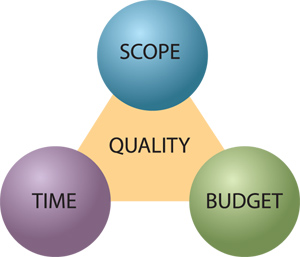
Project management is the discipline of planning, organizing and managing the resources to ensure the project meets its goals, within the triple constraints of scope, time and budget. Each of these affects the fourth constraint: quality. These constraints conflict with each other and can be illustrated by a triangle: Scope, time and budget are at each apex of the triangle, and quality is in the center.
There are two great values of project management. The first is in enabling the manager to foresee problems soon enough to do something about them. The problems usually arise from a lack of resources—time or money—or delays in subtasks that affect the dependent tasks. The solutions involve reallocating resources and changing the timeline of the task or the entire project. If this is done right, the impact of the problem can be lessened or eliminated.
The second value is in forcing the manager to take a broad view of the project at regular intervals. As the builder, you can get tunnel vision from working on a small part or subassembly, sometimes literally inches from your nose. You might forget the uncompleted sections of the previous subassembly or overlook that parts need to be ordered before a task can be completed. By regularly revisiting the whole project plan, the builder refocuses on the larger view and can remove any roadblocks.
There are four tools commonly used in project management:
- Brainstorming
- Fishbone diagrams
- Critical path analysis
- Gantt charts
Brainstorming is unstructured thinking. The object is to generate as many ideas related to the problem as possible. It is conducted in a non-judgmental environment where there is no such thing as a bad or unworkable idea. Different colored pens may be used to distinguish between things, relationships and measures. Once the ideas have been generated, they may then be rated for feasibility, but it’s essential to keep these two activities separate during the brainstorming session.
Fishbone diagrams, or cause-and-effect diagrams, have a central spine running from left to right, around which is built a map of factors that affect the final result or problem solution. The solution is usually obvious once all of the causes are listed in the diagram.
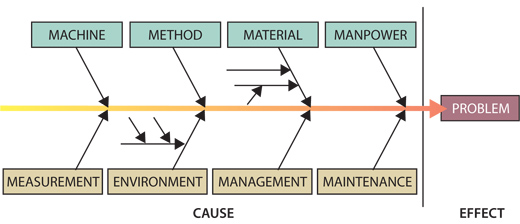
Fishbone diagram.
Critical path analysis is a mathematical model that calculates the total duration of a project based on individual task durations and dependencies, and it identifies which tasks are critical. While many activities can proceed in parallel, some must be completed in series. The sequential tasks that represent the longest time span are known as the critical path. For the project to be completed on time, tasks located on this path cannot be delayed. In the example, the critical path is M1-M2-M4-M5-M6-M7, and the duration is 10 weeks. Path M1-M2-M3-M6-M7 has a duration of seven weeks and a float of three weeks (10 – 7 = 3).
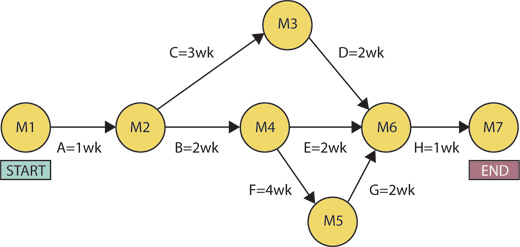
Critical path diagram.
The charting system that plots activities across a timescale is called a Gantt chart. These charts are excellent at presenting scheduling and budgeting, and for reporting on project progress.
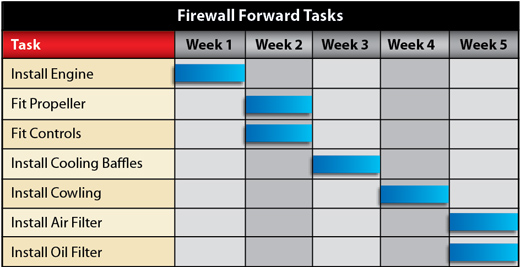
An example of a Gantt chart.
The tools mentioned above may all be used manually or on a simple spreadsheet. The most important attribute for any airplane-building project is that the tools are easy to use and update. Specialized software is available, sometimes as freeware, to format the tools properly and to ensure dependencies are maintained. However, if you are not proficient in using the software, it’s probably better to use the simpler methods.
Changes are inherent in a complex project such as a building an airplane. You might make a preliminary decision about a piece of equipment, but by the time you are ready to buy it, the technology may have advanced or the manufacturer may no longer support it. The best way to deal with this is to stay current with the state of technology for the equipment you intend to use, whether it’s an engine, a prop, avionics or fluid systems. As you see trends emerge, or as better equipment becomes available, you can evaluate it in time to include it in your budget and project plan.
If you are the only one involved with your project, you need only your own support and commitment. However, for most builders, there are other stakeholders—a spouse, children, family members or friends. The stakeholders are critical to the success of your project, and you’ll want to maintain their support. One of the purposes of the project plan is to inform stakeholders of their roles and set ground rules. For example, children may be welcome to participate, but a ground rule may be that an adult must accompany them. Or perhaps your spouse is a building partner, and the ground rule is that there are no project activities on Sundays or during vacation time.
Speaking of time, this precious resource must be scheduled, especially for the primary builder. A typical airplane project takes about 2000 hours to complete. If you really work at it, your project could be done in a year! However, if you spend eight hours every Saturday, it will take you 250 weeks, or almost five years, to complete. Keep in mind that this is normally a spare-time project, so shop time must be scheduled around your other commitments. The easiest way to ensure continued progress is to take the advice of experienced builders who have completed their projects: Do something every day, even if only the smallest task. The mere act of getting into the shop and picking up some tools will turn into a habit, and you will be able to watch your project grow. It takes only an hour and a quarter per day to beat the fellow who works eight hours every Saturday. But what if you travel during the week and are away from the workshop? Many professional pilots, sales representatives and others who travel take along their kit manual and a few parts, and they work on these in the hotel at the end of the day. (No, I don’t know what the maids think when they find aluminum shavings or fiberglass strands in the carpet of the hotel room.)
For solo builders, the responsibility matrix is easy: They get to do everything themselves. But for those who have a partner, spouse, family or friends helping them, a responsibility matrix will go a long way toward keeping the project on track. If a team member has a special skill or knowledge, this should be included in the responsibility matrix so they can maximize their contribution. And even the solo builder will probably buy an engine and an instrument panel, so the suppliers of these items should be included in the responsibility matrix.
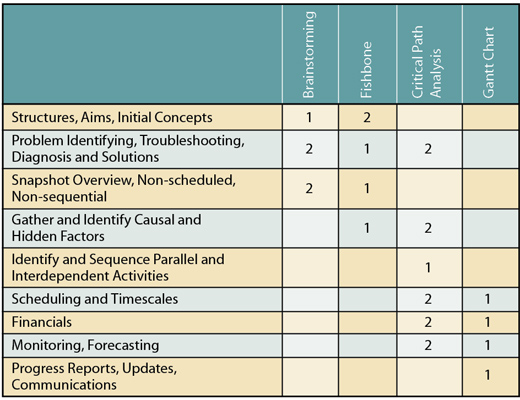
Project management matrix diagram.
If a major subassembly such as an engine or instrument panel, or processes such as paint, are subcontracted, it will be worthwhile to draft a formal agreement with the supplier. This agreement is a subcomponent of the overall project plan. The purpose of the agreement is to mitigate risk to the project finances and timeline. It should include:
- Technical management. Exactly what work is to be done?
- Financial management. Who pays what and when?
- Time management. What is the pace for the job?
While this may take the form of a contract, it really is a subtask in the overall project plan and should be managed as such.
Setting milestones and target dates may seem a tedious part of project management at the start, but the advantage soon becomes apparent as the milestones approach. Anticipation grows, and then, on the magic day, a subassembly is completed. This is cause for celebration. Builders may invite friends over to the workshop or post a notice in an online builders’ forum. Whatever the most appropriate celebration is, each leads to the final one: the completed project. Each of these milestones is a strong motivator and an incentive to keep going.
Finally, the project plan should be printed out at regular intervals and after all major revisions. This will form a record of the project, making it easy to see how the risks were mitigated and how the actual project compared to the original plan. This is especially valuable for your second homebuilt aircraft. You are planning to build a second one, aren’t you? (The building can be as addictive as the flying.)
Motivational Tools
Wanting to build an aircraft and actually motivating yourself to do it are two different things. Self-motivation is the force that drives us to achieve, produce and build. With self-motivation you learn and grow; it’s a fundamental tool for achieving your dreams. But not everyone has the same level of self-motivation, and even the most motivated people need help now and then.
The four factors contributing to a high level of self-motivation are:
- Self-confidence.
- Positive thinking.
- Strong goals and focus.
- Motivating environment.
Self-confidence is the belief that you can succeed. Recognize the successes that you have had in the past and understand the behavior patterns that got you there. This will inspire you to achieve success in the future.
Positive thinking is related to self-confidence, but it is slightly different. Positive thinking allows you to develop a plan of action and implement it in the face of a setback or problem. It allows you to develop, and retain, a picture of success.
When you set a strong goal, you make a promise to yourself to achieve that goal. You develop a plan to achieve it. With the plan in place, you will be able to focus on the tasks required.

If sitting in your as-yet-unfinished airplane making engine noises keeps you motivated, then by all means do it.
Even with the first three factors, a motivating environment is still necessary for success. Your shop should be set up so that it is a pleasant place to work, stocked with the necessary tools and materials. Your computer and reference library should be conveniently located and easy to use. Your spouse or family must support your project even if they do not actually work on it. You should also develop a community of fellow builders who can help if you get stuck. But more than that, if you are cursed with doubters, time-wasters or people who lack the self-confidence to undertake a project of their own, you should minimize their negative impact on your project.
As with most of the tools discussed so far, there are some good online tests for self-motivation that let you assess your skills. Often, there are also exercises to help you improve.
Finally, be aware of burnout. Everyone has a different threshold for this, and a major project such as a homebuilt aircraft that takes months or years to complete can be a recipe for it. The best advice is to be aware of the possibility. If you have completed previous projects, you may be aware of your limits in terms of the physical or mental work, or of your tolerance for frustration and setbacks.
If you feel the signs of burnout, take a break. Do something different. Go on vacation, play some sports or enjoy the weather. But also be aware that the project will eventually need to be restarted, and this may require extra effort after an extended break. It may be better to tackle a different part of the project to get you restarted. If you have developed the four motivational tools, especially the motivating environment, you should have no trouble restarting your project once you have taken that needed break.

Trying the demo plane on for size at an airshow while your own is in the process of being built can remind you of why you took on the project.
Aircraft Philosophy
If you are already a pilot or a student of aircraft technology, you have acquired a great deal of knowledge about the subject. By exploring the tools discussed here, you will have added to the depth of your knowledge. This knowledge becomes the basis of an understanding of the philosophy of aircraft.
Aircraft are unlike any other form of transportation because they must combine a high degree of reliability with light weight. A typical four-place automobile has an empty weight of about 3500 pounds, while a typical four-place airplane has an empty weight of about 1600 pounds. The automobile has a length of about 16 feet and a width of about 6 feet. The aircraft has a wingspan of about 35 feet and a length of about 30 feet. Ships float in water that is 800 times as dense as air, so weight is rarely a concern.
With the difference in density between air and other fluids as the driving influence, as well as differences in operating temperature, altitude and speed, aircraft have evolved over the last hundred years to vary from other machines in their materials, structures and systems. The homebuilder must keep this in mind over the course of the project.
With insufficient knowledge of the correct aircraft practices, it is easy for the homebuilder to overbuild or underbuild any changes or improvements. The problem with overbuilding is that it adds unnecessary weight, which will affect all aspects of aircraft performance. Underbuilding could result in a bracket or structure that is neither strong nor stiff enough to react to the loads, and ultimately the part will fail.
These problems are not confined to structure. It is quite easy to end up with an oversized fuel pump, undersized fuel lines and wires that are too heavy or have insufficient current carrying capacity.
Any one of these problems can result in an incident or an accident, so it should come as no surprise that much of the philosophy of aircraft design and construction has resulted from failures. We should do our best to use what others have learned, as it has come at a high price.
One of the great freedoms we have as homebuilders is to experiment and try new things. With this freedom comes the responsibility to build a safe machine that takes advantage of the knowledge others have gained.
Summary
We have looked at tools that a homebuilder may use to increase the quality and enjoyment of a project and decrease the time required to complete it. We have discussed ways of developing skills, planning and tracking the pro-ject, and keeping it moving forward. So remember, when you are stocking your workshop with compressors, drills, saws and rivet guns, there are lots of other tools that you can use to help you realize your dream.











